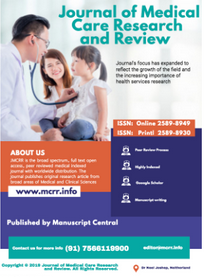Bacterial pathogens and their susceptibility to antibiotics among mothers with premature rupture of membranes at a teaching hospital in western uganda
Abstract
Background: Premature rupture of membranes (PROM) remains a great burden to mothers and their unborn children all over the world with several adverse maternal and fetal outcomes. This study aimed at determining common bacterial pathogens and their susceptibility patterns in women with PROM at Kampala International University Teaching Hospital (KIU-TH). Methods: This was a cross-sectional study conducted in the months of September 2019 to November 2019. A total of 334 pregnant mothers above 28 weeks of pregnancy admitted in maternity ward of KIU-TH were consecutively enrolled. Interviewer administered questionnaires and laboratory forms were used to collect data. Endocervical swabs were obtained from those with PROM and taken to the laboratory for culture and susceptibility tests. Descriptive statistics were used using STATA 14.2. Results: 46 (13.8%) mothers had PROM. Of these, the most common bacterial pathogens identified were S. aureus (29.6%), E. coli (25.9%) and N. gonorrhoeae (25.9%). Antibacterial susceptibility tests revealed highest sensitivity to imipenem (100%), nitrofurantoin (92.6%), cloxacillin (85.2%) and azithromycin (81.5%). Total resistance to amoxacillin, ceftriaxone and ampicillin was found. Conclusion: Women with PROM predominatly have Staphylococcus aureus, Escherichia coli and Neisseria gonorrhoeae. Imipenem, nitrofurantoin, cloxacillin and azithromycin are the most effective antibiotics among patients with PROM.
Full text article
References
Shadma K, Aymen AK. Study on preterm pre mature rupture of membranes with special reference to maternal and its fetal outcome. Int J Reprod Contraception, Obstet Gynecol. 2016;5(8):2768–74.
Nourossadat K, Maryam A, Mehdi H, Masoumeh F, Hamid AM. Diagnosis of premature rupture of membranes by assessment of urea and creatinine in vaginal washing fluid. Iran J Reprod Med. 2013;11(2):93–100.
Cunningham FG, Leveno KJ, Bloom SL, Dashe JS, Hoffman BL, Casey BM. Williams Obstetrics. 25th ed. McGraw-Hill Education; 2018.
Kayiga H, Lester F, Amuge PM, Byamugisha J, Autry M. Impact of mode of delivery on pregnancy outcomes in women with premature rupture of membranes after 28 weeks of gestation in a low-resource setting : A prospective cohort study. PLoS One. 2018;991(1):1–13.
Birkneh TT, Elizabeth AA, Stefano O, Joshua H, Miranga W, Iveth JG, et al. Antimicrobial resistance in Africa : a systematic review. BMC Infect Dis. 2017;616(17):1–17.
UNAS. Antibiotic Resistance in Uganda : Situation Analysis and Recommendations. 2015.
MOH U. Uganda Clinical Guidelines. 2016;
Daniel WW. Biostatistics. A Foundation for Analysis in the Health Sciences. John Wiley & Sons, Inc.; 2009.
Thomson AJ. Care of Women Presenting with Suspected Preterm Prelabour Rupture of Membranes from 24 + 0 Weeks of Gestation. BJOG. 2019;126(73):152–66.
Cheesbrough M. District laboratory practice in tropical countries. Vol. Part 1, District laboratory practice in tropical countries Part 2. 2006. 442 p.
Connie RM, Donald CL, George M. Textbook of diagnostic microbiology. 5th ed. Maryland Heights, Missouri.: Saunders, Elsevier.; 2015.
Zeng L, Zhang L, Shi J, Gu L, Grogan W, Gargano MM, et al. The primary microbial pathogens associated with premature rupture of the membranes in China : A systematic review. Taiwan J Obstet Gynecol. 2014;53(4):443–51.
Gahwagi MMM, Busarira MO, Atia M. Premature Rupture of Membranes Characteristics , Determinants , and Outcomes of in Benghazi , Libya. Open J Obstet Gynecol. 2015;5(8):494–504.
Musaba MW, Kagawa MN, Kiggundu C, Kiondo P, Wandabwa J. Cervicovaginal Bacteriology and Antibiotic Sensitivity Patterns among Women with Premature Rupture of Membranes in Mulago Hospital , Kampala , Uganda : A Cross-Sectional Study. Infect Dis Obstet Gynecol. 2017;2017(6):1–7.
Top KA, Buet A, Whittier S, Ratner AJ, Saiman L. Predictors of staphylococcus aureus rectovaginal colonization in pregnant women and risk for maternal and neonatal infections. J Pediatric Infect Dis Soc. 2012;1(1):7–15.
Doster RS, Kirk LA, Tetz LM, Rogers LM, Aronoff DM, Gaddy JA. Staphylococcus aureus Infection of Human Gestational Membranes Induces Bacterial Biofilm Formation and Host Production of Cytokines. J Infect Dis. 2017;215(4):653–7.
Adewumi O, Olofinbiyi B, Oyekale O, Loto O, Abu S, Sotunsa OJ. Microbiological Pattern in Preterm Prelabour Rupture of the Fetal Membranes in South-Western Nigeria. Obstet Gynecol Int Journal. 2017;6(4):4–10.
Salou M, Lack F, Adama-hondegla AB, Dossim S, Tsogbalé N, Gbadoé A. Premature Rupture of the Membranes at the Sylvanus Olympio University Hospital of Lomé , Togo : Microbiological Findings and Outcomes. Am J Infect Dis Microbiol. 2015;3(6):152–6.
Rani S, Mehra R, Gupta V, Huria A, Chander J. Vaginal flora in preterm premature rupture of membranes and their sensitivity to commonly used antibiotics. Asian J Med Sci. 2014;5(4):58–60.
Annie R, Thomas SK, Sarah J, Neha MB. Microbiological Profile of PROM in a Tertiary Care Centre in Mangalore,Karnataka State. Int J Heal Sci Res. 2014;4(October):72–6.
Eleje G, Adinma JJ, Ghasi S, Ikechebelu JJ, Igwegbe OA, Okonkwo EJ, et al. Antibiotic susceptibility pattern of genital tract bacteria in pregnant women with preterm premature rupture of membranes in a resource-limited setting. Int J Gynecol Obstet. 2014;1(3):7–11.

